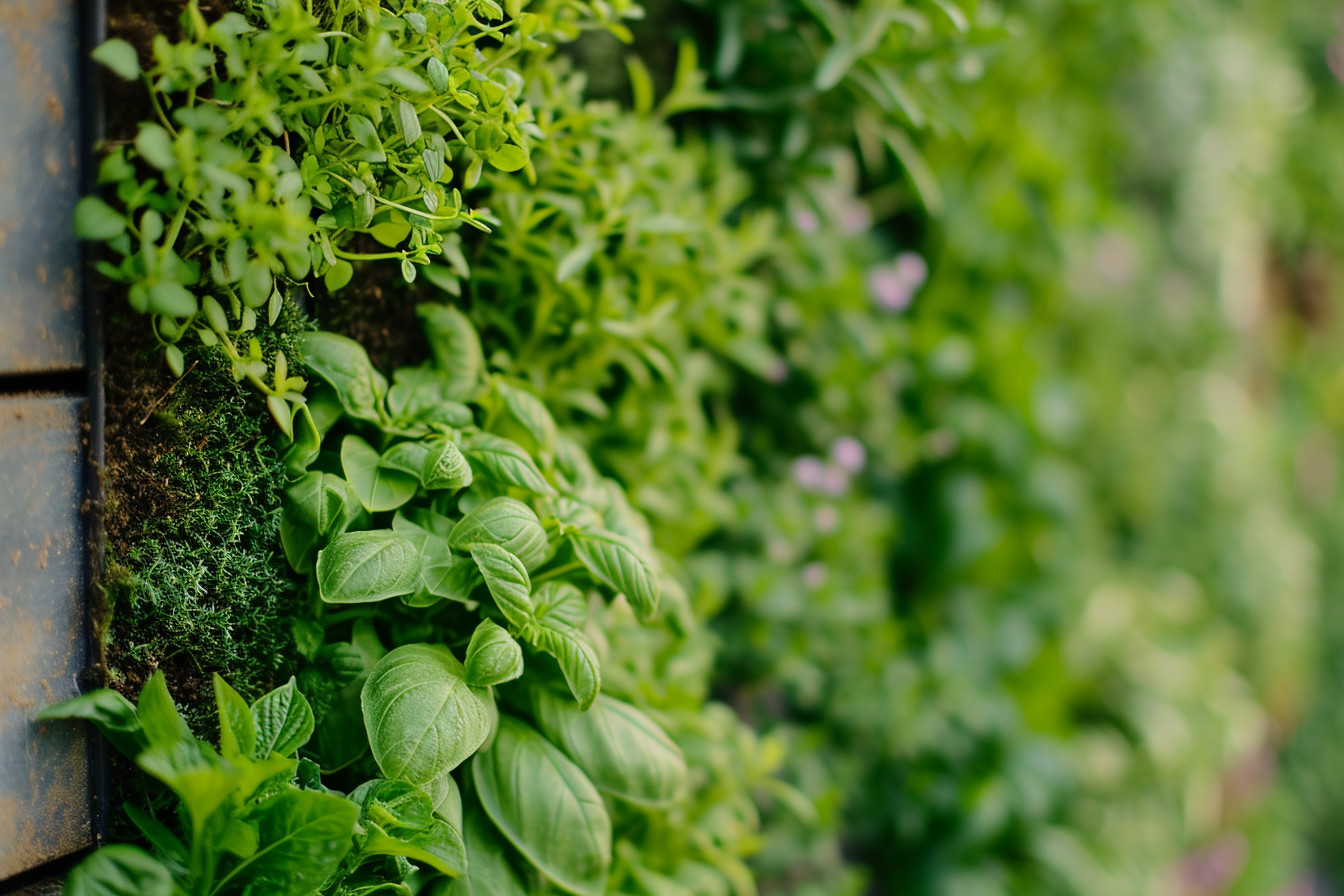Ever found yourself daydreaming about a lush, green sanctuary but you’re short on space? That’s where vertical gardens come in, my friend. They’re the perfect solution for urban dwellers craving a slice of tranquility. I’ve been growing herbs vertically for years, and let me tell you, it’s not just a space-saver—it’s a game-changer.
I’m all about sharing the love, so I’ve put together this handy guide to help you get started. Whether you’ve got a tiny balcony or just a sliver of sunlight in your kitchen, growing herbs vertically is surprisingly simple and incredibly rewarding. Trust me, there’s nothing like snipping fresh basil right off the wall for your homemade pesto.
Choosing the Right Herbs
When I’m nestled in my little nook of greenery, it’s easy to feel at one with nature. There’s something quite meditative about tending to my vertical garden—it’s my serene escape in the bustling city. Selecting the right herbs for this garden is a crucial first step, one that’s both practical and a bit like crafting a personalized botanical playlist.
Imagine picking a variety of herbs that don’t just survive but thrive in your unique space. The key is to choose herbs that suit your climate and the amount of sunlight your vertical garden receives. My go-to herbs are usually basil, mint, and thyme—all hardy plants that can cope with the dappled light on my balcony.
But before you start planting, let’s breathe in the basics. Hardy herbs like rosemary and oregano can endure less frequent watering and sporadic sunshine. On the other hand, cilantro and chervil fancy a bit more attention and a consistent schedule. Good drainage is non-negotiable, as herbs prefer not to have wet feet.
There’s a tale I often recount about my first foray into vertical gardening. It was a journey starting with ambitious dreams of lavish greenery and ending with a newfound wisdom. A poorly chosen assortment of delicate herbs taught me that certain plants were simply not meant for the limited sunlight of my east-facing wall. You can imagine the dismay I felt, bidding farewell to my wilting friends. So, lesson learned—research and match herbs to your environment, not just your culinary preferences.
For beginners, I’d suggest starting with these:
- Basil
- Mint
- Parsley
- Chives
These are fairly low-maintenance and will give you the confidence to expand your garden. As you become more attuned to the needs of your plants, experimenting with more exotic herbs like lemon balm or tarragon can be a fascinating adventure.
Let’s not forget that a flourishing herb garden serves more than just an aesthetic or culinary purpose; it’s a sanctuary for bees and beneficial insects. Planting a mix of flowering and non-flowering herbs will ensure that your vertical oasis is buzzing with life, quite literally.
Selecting the Perfect Location
Choosing the right spot for a vertical garden feels like a quest for that sweet spot, where my plants will flourish with life. There’s a whole lot more to it than picking a patch of sunlight. It’s about finding harmony where the garden’s needs and the daily rhythms of nature intersect seamlessly.
In the heart of city living or the quiet suburbs, I’ve discovered that certain factors are non-negotiable when selecting the perfect locale for an herb oasis. First off, proximity to sunlight is key. Though herbs like basil and mint are pretty adaptable, they do need their fair share of sunshine to thrive. Each herb’s thirst for light varies, but I’ve found that a spot which gets about four to six hours of indirect sunlight is gold for most varieties.
While contemplating potential sites, I consider visibility. Do I want my herbs to be a centerpiece, greeting guests with their aromatic splendor? Or maybe a more functional spot where they’re easily accessible from the kitchen? A vertical garden is versatile, so it fits into small balconies and expansive backyards alike. It’s incredible how a well-placed vertical garden can transform a bare wall or railing into a lush green space.
Protection from the elements is another aspect I take into account. Too much wind can lead to dry soil and damaged plants, so finding a location sheltered from gusty conditions is a priority. And while herbs love the sun, too much direct exposure, especially during a heatwave, can be harmful. It’s about balance and observing the way elements play out in your space over time.
Let’s get down to brass tacks. The technical side of things is critical for a garden’s success. Gardeners should be mindful of the structure’s weight and the integrity of the wall or railing it’ll hang on. Safety first, my friends! Don’t overload the space or opt for a vertical garden setup that’s too heavy for your infrastructure. It’s better to start small and expand as you get the hang of it.
But it’s not just about ensuring your vertical garden stays up. Water access is practical and oh so necessary. Hauling water cans back and forth can get old pretty fast. I like to have a hose or watering system within easy reach to keep my herbs happy and hydrated without the extra legwork.
Setting up Your Vertical Garden
Stepping into a garden always washes a wave of serenity over me, and there’s something extra special about crafting a vertical garden. It’s like painting a living mosaic on the canvas of your wall. Let me guide you through setting up your own vertical garden, where the air will soon be fresh with the scent of herbs and your hands, happily dirty.
Selecting Containers and Pockets
The first step is nailing down what you’ll use to hold your plants. I love using a mix of recycled containers and specially designed pockets. They’re not only eco-friendly but also add an eclectic charm to the space. Ensure they have adequate drainage; roots don’t enjoy a constant bath! Oh, and while you’re at it, make sure the containers are secure. We don’t want any surprise showers of soil and plants on anyone, right?
To set up, I actually use a simple frame made from lightweight materials like PVC or aluminum. Attach the containers or pockets to this frame, and bam, you’ve got the skeleton of your vertical garden.
Soil and Plant Selection
Choosing the right soil is critical for vertical gardening. You’ll want a potting mix meant for container gardening: it’s lighter than your typical garden soil and retains moisture without becoming waterlogged. When I pick herbs for my vertical oasis, I look for:
- Herbs that don’t mind a bit of shade, especially if the garden isn’t in the sunniest spot
- Varieties that grow well together; we’re talking about neighbors, so good companionship is a must
I tend to lean towards herbs like mint, basil, and chives. They’re hardy, versatile in the kitchen, and let’s be honest, they smell heavenly.
Watering System
You might think watering could be a drag with all those plants up on a wall, but it’s not. I installed a drip irrigation system and it was a game changer. Each plant gets a steady drink, and it practically runs itself. If you’re more of a hands-on person, however, a watering can with a long spout works wonders for top to bottom watering.
Maintenance Tips
Providing Adequate Sunlight and Water
When I’m cultivating my own slice of green tranquility, I often muse on the dance between sunlight and water, two pivotal elements that breathe life into herbs. There’s something inherently peaceful about watching the sun’s rays filter through leaves, casting a glow that seems to energize not just the plants but my own spirit as well.
Each morning, I step into my garden and assess the sunlight dappling through the foliage; it’s crucial for photosynthesis, the very heartbeat of my leafy friends. Herbs in a vertical garden are particularly unique; they don’t just stretch out towards the sky but climb up towards the light. It’s fantastic to see this in action, akin to a quiet yet determined upward journey.
Choosing the Right Spot: It’s essential to ensure your vertical garden faces a direction where it can receive at least three to four hours of direct sunlight daily. However, some herbs, like basil, thrive with more, while others, such as mint, favor a bit of shade. I’ve learned to compare my garden’s light exposure with the needs of my herbs, arranging them so that each gets its ideal amount of sun.
Watering Systems: Not to be outdone, water is the elixir that sustains life. I’ve set up a drip irrigation system for my vertical garden; it’s like giving my plants a steady IV drip, ensuring they get their hydration without overwhelming them. This method not only saves water but also time—it’s gardening made efficient. Moreover, the system mimics rainfall, which plants adore, allowing water to penetrate deep into the roots while keeping the leaves dry to prevent disease.
| Watering Frequency | Herb Types | Drip Irrigation Setting |
|---|---|---|
| Daily | Basil, Chives | 30 minutes |
| Every Other Day | Mint, Parsley | 20 minutes |
| Twice a Week | Rosemary, Thyme | 15 minutes |
Creating a watering schedule helps me keep track without forgetting any thirsty herbs. I’ve noticed that they seem to perk up after their scheduled drinks, a subtle reminder of the cycles of growth and rejuvenation.
Maintaining and Harvesting Your Herb Garden
As I stroll through my vertical oasis, I can’t help but bask in the peaceful serenity it brings to my urban living space. I love to share that maintaining your herb garden is much like nurturing a friendship; it requires attention, care, and a bit of know-how.
Tending to Your Herbs
First off, let’s talk about maintenance. Regular check-ups are the backbone of keeping your garden thriving. Look out for pests and diseases, which would prefer to feast on your herbs before you can. If you spot anything amiss, organic pesticides or insecticidal soaps can be effective remedies.
Trimming is another key action point. By snipping the tops of your plants, you encourage bushier growth and prevent them from becoming too leggy. As for the soil, keep it light and air-rated with occasional, gentle tilling. Remember, compact soil is a no-go for the roots that crave breathing space.
Watering is a tad specific, I’ve found. Overwatering can lead to root rot, while underwatering can stress the plants. Strike a balance, sticking to the schedule I mentioned earlier and adjusting as needed for rainfall and temperature changes.
When to Harvest
Harvest time is like the grand finale of your garden’s show – it’s exciting, fulfilling, and a testament to your diligent upkeep. The best time to harvest is in the morning when the plant’s oils are at their peak, making for the most flavorful herbs you’ll savor in your dishes.
One thing I always keep in mind – it’s best to harvest herbs before they flower, as that’s when they’re in their prime.
Optimal Harvesting Techniques
- Use clean, sharp scissors or shears.
- Cut above a leaf node to encourage new growth.
- Don’t harvest more than one-third of the plant at a time to allow it to recover.
Drying and Storing
If you’re planning on saving some of your bounty for later, drying your herbs is a simple process. Tie them in small bunches, hang them upside down in a dry, airy space, and let time do the rest. Once dry, store them in airtight containers and label them; trust me, crumbled basil and oregano look all too similar without their customary green luster.
Final Thought
Growing herbs in a vertical garden has been a rewarding journey for me. I’ve loved watching my little green friends thrive in their cozy vertical homes. Remember, the key to lush, flavorful herbs is all in the TLC—tender loving care. Keep an eye out for those sneaky pests, give your plants the right snip-snip to promote growth, and don’t forget that water is their best friend (but not too much!). When it’s time to harvest, trust me, there’s nothing like the taste of herbs picked fresh from your own garden. Now go ahead, dry and store those aromatic leaves and enjoy your homegrown flavors all year round. Happy gardening!









